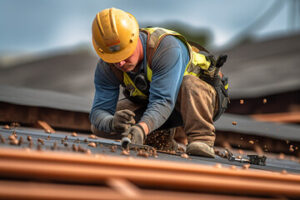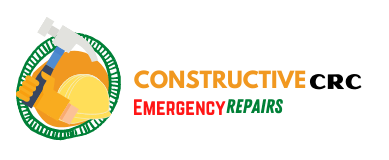Metal roofing is a great option for your home, especially since it adds to the resale value. However, consider a few things before making this investment. Always start with the eaves and work up, overlapping each panel. Install the outside closure strip (vented or solid), and follow manufacturer instructions for installing the ridge cap.
 The installation of a metal roof can be a dangerous project. Because of its size, fragility, and weight, it’s best to leave this work to metal roofing professionals. When you do hire a crew, be sure to check their references and insurance coverage before hiring them. Builders is insured for general liability and workers’ compensation insurance. They should also have extensive experience installing metal roofs.
The installation of a metal roof can be a dangerous project. Because of its size, fragility, and weight, it’s best to leave this work to metal roofing professionals. When you do hire a crew, be sure to check their references and insurance coverage before hiring them. Builders is insured for general liability and workers’ compensation insurance. They should also have extensive experience installing metal roofs.
The safety measures that must be taken when working with a metal roof include wearing slip-resistant boots, gloves and a hardhat. The installer should also have a harness to avoid falling off the roof. In addition, he should be aware of wires and tree branches that could fall on the roof. It’s also a good idea to have a backup plan in case the weather turns bad during the project.
One of the biggest risks involved in a metal roof installation is falling off the roof. This can be a serious injury that requires hospitalization. To reduce this risk, the installer must follow the Occupational Safety and Health Administration’s guidelines for residential construction. He should use a ladder that’s 1 foot away from the building for every 4 feet of the building’s height. He should also make sure to secure the ladder with a strap when not using it.
It’s also important to avoid walking on the roof unless necessary. Doing so can cause dents and scratches in the metal panels. In addition, the panels may not be securely fastened to the roof frame and sheathing. To prevent this, the installer should install closure strips consisting of foam rubber. This will seal the gap between the panel and underlayment and prevent rodents from nesting in the space.
Although metal is a tough material, it can still be damaged by large hailstones during a storm. These stones can cause denting in the metal, and you should have adequate homeowner’s insurance to cover this damage. Another advantage of metal is that it’s fire-rated and less likely to catch fire than shingles. It’s also more effective at deflecting and diffusing lightning strikes.
Time
Whether you choose to hire a roofing contractor to install your metal roof or to do it yourself, the project will take time. It is essential that you find a day with good weather and no chance of rain to work on the project. Also, be sure that you have all the necessary tools before beginning. This will help avoid mistakes that could slow the project down significantly.
You will need a ladder and safety gear to access your roof. You will also need to remove any existing shingles or other roofing materials. After completing the initial cleanup, you will need to lay down a moisture barrier or insulation layer. This step is required to protect the sheathing, roof framing and ventilation. This will also protect the metal from corrosion caused by the sun’s UV rays and other environmental factors.
After the initial layer of insulation and moisture barrier, it is time to add the metal panels. Start at the peak and work your way down to the eave. It is important that the panels overlap each other by at least six inches. If you need to, you can cut the panels to fit using tin snips or a circular saw. Before installing the ridge cap, you should determine whether or not your roof is vented at the ridge and if so, you will need a vented closure strip.
A ridge vent will help prevent water damage, increase air flow and reduce energy costs. It is important to follow the manufacturer’s instructions for installation and to use a sealant to prevent leakage. Once the ridge cap is installed, run another strip of sealant tape along the top and on both sides of the roof. This will further seal the gap and prevent rodents from nesting in it.
Trim and flashing are the finishing touches that make your roof look great and create a tight and sealed environment. There are three types that almost every roof will require:
The eave trim is the first piece of trim installed on the roof. It is used when gutters are not needed and helps to finish off the low side of the roof. It also directs water away from the side of the home.
Money
Whether your home is in need of a roof or you are looking to add some curb appeal, metal roofing is an excellent choice. This durable material offers contemporary style, extended warranties (30 to 50 years), and fire resistance. It is also highly affordable compared to asphalt shingles, making it an attractive option for homeowners. However, metal roof installation can be a complex task, and unless you are an experienced DIYer, it is best to hire a professional. This will not only save you time and money, but it will ensure the safety of your home during the project.
The initial cost of a metal roof is typically higher than that of traditional shingle products, but it is offset by the savings in energy costs. Moreover, metal roofs can be installed over existing shingles, saving you the labor cost and landfill charges for disposing of them. In addition, metal roofs are more energy efficient and can qualify you for tax credits.
Other factors that impact the cost of a metal roof include trim and flashing, which seal and finish the edges between panels. These products are available in a variety of materials, but the most common options are gable trim, ridge cap, and eave flashing. Gable trim is installed around the peak of the roof and is usually installed where two slopes meet. It usually costs $2-$4.50 per linear foot.
Another factor that impacts the cost of a metal roof is the type of underlayment needed. The underlayment is the synthetic or felt layer that sits between the metal roof and your home’s framing. It is generally required to protect the structure from water and other weather conditions, so it can be quite expensive.
Getting your metal roof installed by a licensed contractor will help you avoid costly mistakes and ensure the durability of your new roof. However, if you’re willing to take on the challenge yourself, there are many online resources to guide you through the process. You can even get matched with up to four contractors to find the best one for your job.
Expertise
A metal roof installation requires specialized tools and knowledge of the product and its installation methods. It is important to choose a contractor that is experienced in all types of metal roofing and has a strong understanding of building codes and regulations. They should also have a clear understanding of all the different types of panels and fasteners available. If they are not, they may install your roof incorrectly, which can cause leaks and other problems.
Choosing a metal roof installer with extensive experience and training can help you avoid costly mistakes. In addition, they should be able to provide a list of references from satisfied customers and a detailed description of their work. The best metal roof installers will also offer warranties on their work, which demonstrate that they stand behind their craftsmanship.
Many homeowners attempt to install metal roofs themselves without proper preparation and tools. They often cut the metal wrong and leave rough edges that can lead to rust or roof coating failure. They also fail to use clips properly or screw in fasteners too tight. Leaks are almost always due to these errors, and a professional metal roof installer will know how to prevent them from occurring.
Before starting your project, it’s a good idea to get a permit from your local building department. This will ensure that your work is done properly and that you’re not causing any unnecessary damage to your home. In addition, it will prevent you from being fined for a violation.
If you’re installing a metal roof over an existing roof, be sure to build a grid to support the new material. This will help reduce the weight load on your existing roof structure and prevent it from sagging or failing. The grid can be constructed out of 1 x 4 metal purlins or beams.
Once the grid is installed, you can begin putting in the metal panels. Start with the eaves and then move up the roof, overlapping the small edge of each panel over the large edge. Use tin snips or a circular saw to cut the panels as needed for fit. Make sure the screws are securely fastened, but don’t over tighten them or they can pull the panel down and cause a leak.

